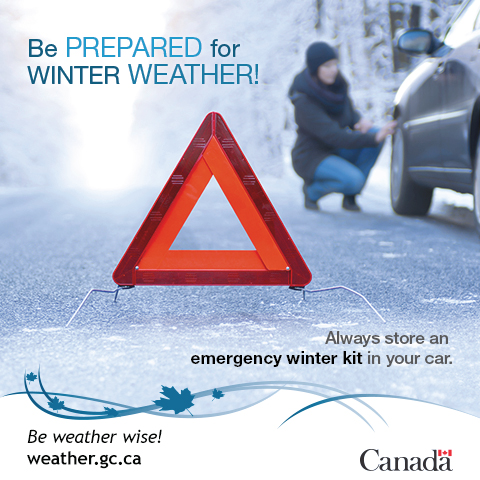Severe winter weather alerts
Spending time outdoors in the winter season is good for your health, and can be a lot of fun. But you need to be aware and prepared for Canada’s cold and severe winter weather. In an average year, more Canadians die from exposure to winter cold than from lightning, wind storms and tornadoes combined.

Photo © Environment Canada, 2014.
When severe winter weather threatens, Environment Canada issues special alerts that notify Canadians in affected areas so that they can take steps to protect themselves and their property from harm. These weather alert bulletins are issued through the media, as well as through the Weatheradio service, and the Government of Canada’s weather website.
Canada has one of the most severe winter climates of any country in the world. We experience a wide variety of dangerous weather conditions including extreme cold, blinding blizzards, and treacherous ice storms. Even conditions more typical of the warmer months such as heavy rain and lightning are possible in winter.
Anyone who has ever waited at a bus stop or taken a walk on a blustery winter day knows that you feel colder when the wind blows. This cooling sensation that is caused by the combined effect of temperature and wind is what is known as wind chill. The best way to avoid the hazards of wind chill is to check the weather forecast before going outside, and to be prepared by dressing warmly.
And it’s not just the weather itself that can have serious consequences, but also the rapid transitions between weather types or the long durations of any one particular type that occur from time to time. It’s one thing to be prepared for the cold, snow and ice, but are you ready for those times when the weather changes in the blink of an eye or when nasty conditions seem to go on forever?
This is why it’s important to be aware of the various weather alerts available from Environment Canada, which are issued to help you make informed decisions.
Four Types of Wintertime Alerts
The type of alert used depends on the severity and timing of the event:
- Special Weather Statements are the least urgent type of alert. These are issued to let you know that conditions are unusual and could cause concern. They provide a heads up of what weather may be coming.
- Advisories are issued for specific weather events (like blowing snow, fog, freezing drizzle and frost) that are less severe, but could still significantly affect Canadians.
- Watches alert you about weather conditions where there is potential for a significant storm or severe weather to occur. As certainty increases about the path and strength of a storm system, a Watch could be upgraded to a Warning.
- Warnings are urgent messages that severe weather is either occurring or will occur. These alerts are updated regularly so that you can stay informed and take appropriate action.
Of the above types of alerts, different weather patterns can bring different types of threats/hazards. These can generally be defined as precipitation events (snow, freezing rain, etc.), extreme cold and wind chill, and reduced visibility. Any of the three threats can arrive alone or in combination of two or more.
Environment Canada issues over 20 different types of alerts for the various weather hazards that are possible across the country.
But to simplify, winter alerts can be categorized into three basic categories (each of which can occur in combination with another):
Precipitation alerts:
- Snowfall - significant snowfall
- Snow Squall - when cold air moves across larger open bodies of water (such as the Great Lakes) creating nearly stationary bands of cloud and snow
- Freezing Rain / Freezing Drizzle - when rain or drizzle falls onto sub-zero surfaces and freezes on contact forming a layer of ice
- Rainfall - significant rainfall
- Winter Storm - issued when multiple types of severe winter weather are expected to occur together
Cold alerts:
- Extreme Cold - extremely cold temperatures or very low wind chill values
- Flash Freeze - issued when a rapid drop in temperature causes water from rain or melted snow on streets, sidewalks etc. to quickly freeze
Poor Visibility alerts:
- Blizzard - issued when winds are expected to create blowing snow giving widespread reduced visibility of 400 metres or less
- Blowing Snow - issued when winds are expected to create blowing snow giving poor visibility of 800 metres or less
There is also a rarely-issued generic alert simply called a “Weather” warning or advisory. These alerts may be issued for weather events for which there is no suitable warning type, because they rarely occur.
More information: